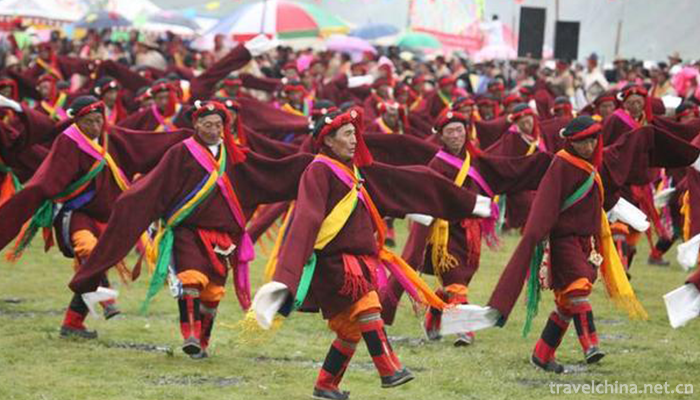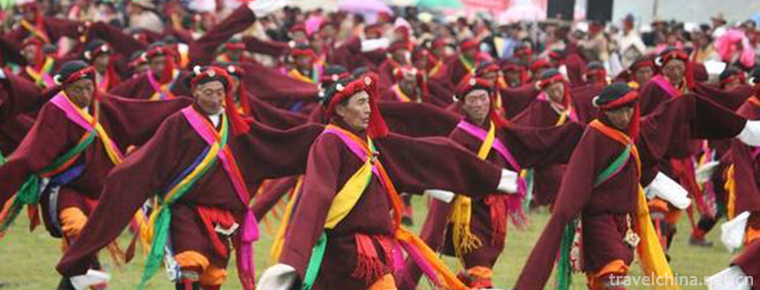Guwo Yushu Samurai Dance
Guwo Yushu Samurai Dance
Samurai dance is a unique style of etiquette folk dance spread in Yushu. It is called Guowa (or Guowa) in Tibetan. Guo refers to weapons in Tibetan. It means warriors with weapons. Wo refers to dancers who perform in important ritual occasions of temples and tribal people.
Historical origin
Historically, Yushu is a famous town of "Tang-Fan Ancient Road". When Princess Wencheng entered Tibet in the seventh century A.D., she had a magnificent journey of "flag display, ceremony opening, magnificence". She stayed here for a long time through Yushu, while resting her whole horse, training soldiers and spreading the original production technology. The princess also sent people to carve a Buddha statue and eight Bodhisattvas statues on the rocks of Beku, Yushu, and built a temple. The opening ceremony was held. The temple was named "Da Ri Tathagata Temple". It was worshipped by the local people. So far, the incense is very strong and the believers are endless.
The princess's entrance to Tibet has played a certain role in promoting the development of Tibetan culture and economy. This kind of honor guard and soldier drill in the Central Plains has been absorbed by the local Ben religion and become the ritual beach of Ben religion. Ben religion is the Tibetan primitive religion. Its main feature is a variety of worship. All things are spiritual. Samurai dance is an important part of Ben sacrificial activities.
When Princess Wencheng entered Tibet, Ben religion was still the state religion of the Tubo Dynasty. The struggle between Buddhism and Benzene had not yet become white-hot. Ben religion, in order to consolidate its dominant position, used the form of ceremonial guard in the Central Plains to strengthen and propagate its doctrine in sacrificial ceremonies.
For example, when performing a warrior dance, the first to appear is a number of warriors, who shoot and shout in order to worship the gods and clean the venue. This kind of shouting guns and shouts are common in Tibetan sacrificial activities. Next came the Tibetan flag and the music of Okingling, Sigu and Rao. Then two rows of warriors with crossbows and swords stepped out slowly and stepped on the music. This was very similar to the situation of Princess Wencheng entering Tibet described in the History of Da Ri Tathagata Temple. It was also similar to the murals of princesses entering Tibet in Tibetan temples we saw. It can be seen that the performance form of samurai dance was indeed influenced by the original Chinese language. Influences of chemical and benzene teaching stalls.
Spiritual meaning
Tibetans are fascinated by the worship of Buddhism, and Buddhism permeates the whole life of Tibetans. Yushu people think that performing Guowa is "God and I are happy together", and it also contains a kind of dignity, praise and perfection, which is the embodiment of self-spirit. Samurai dancers are adult men. They must be devout native people. It is forbidden to impart knowledge to others and women to sing and perform. Otherwise, they are impure to God.
Guowa's performance time must be selected for a specific day, time and star. Everyone not only enthusiastically participates, but also wears the most luxurious clothes in order to be auspicious. Dancers wear high eaves, red spikes, jewelry and jade hanging at the neck, wearing brocade silk ribbon, waist knife, brocade and satin clothes with black and white matching otter skin edge, appear noble, elegant, dignified, this is the highest etiquette dress of Yushu men.
Dance characteristics
Collective large-scale dance, the number of performers is unlimited, generally more than 40 people. Because the participants are middle-aged and old people, with luxurious clothes, solemn music and simple movements, they are dignified, solemn and mysterious.
From the appearance to the end of the dance, the choreography is rigorous, breaking the single change of the traditional folk dance troupe, and combining the ritual of "Yitan" exorcising ghosts and Demons and eliminating disasters with the content of ancient military exercises. Musical instruments with big drums, big rao, big trumpet, magnificent momentum, majestic. Dance emphasizes strength and momentum, calm and steady, bold and stretching.
The formation of warrior dance, no matter how long, as an early folk sacrificial and ritual dance, is very successful in both art and thought. It is a wonderful flower in the early Tibetan folk songs and dances, from which we can see the early Tibetan multi-cultural exchanges and fusion, but also the new era of Qinghai Yushu fresh cultural card.


-
1.Yuanyi Shuangfeng Lake International Tourist Resort
Yuanyi Shuangfeng Lake International Tourist Resort in Anhui Province is a high-level tourist resort integrating Golf and leisure. Located in the beautiful scenery, with a total area of more than 2000
Time 2018-12-23 -
2.Qinghai Tibet Plateau Wildlife Park
Xining Wildlife Park, also known as the Qinghai-Tibet Plateau Wildlife Park, is the only large-scale comprehensive wildlife park in the Qinghai-Tibet Plateau with the highest elevation
Time 2019-02-07 -
3.Wuhan Revolutionary Museum
The Wuhan Revolutionary Museum is located at No. 13 Hongxiang, Wuchang, Wuhan, Hubei Province. It was merged by the memorial hall of the former site of the Wuchang Peasant Movement Workshop
Time 2019-02-24 -
4.Wild Elephant Valley in Xishuangbanna
The Wild Elephant Valley in Xishuangbanna is located in Mengzi Nature Reserve and "UNESCO Man and Biosphere Reserve" of Xishuangbanna National Nature Reserve
Time 2019-02-25 -
5.Daur Folk Songs
Daur people mainly live in Inner Mongolia Autonomous Region and Heilongjiang Province, and a few live in Tacheng County, Xinjiang. Daur means "pioneer".
Time 2019-04-22 -
6.Mongolian Long tune Folk Songs
Mongolian long-tune Mongolian is called "Uri Tudao", which means long song. It is characterized by fewer words, long-lasting, soothing and free, suitable for narration, and longer lyric.
Time 2019-06-04 -
7.Butter Flowers in Tar Temple
Butter flower originated from Benjiao religion in Tibet. It is a small decal on the food supply. According to traditional Indian Buddhist customs, the tributes offered to Buddhas and Bodhisattvas are
Time 2019-06-17 -
8.Wutaishan Buddhist Music
Wutai Mountain Buddhist music refers to the traditional Buddhist music that has been circulating for a long time in the temples of Wutai Mountain, the top four famous mountains of Chinese Buddhism. Wu
Time 2019-06-29 -
9.Sichuan Police College
Sichuan Police College is the only full-time undergraduate college of political, legal and public security in Sichuan Province, which is sponsored by the People's Government of Sichuan Province and jo
Time 2019-08-31 -
10.Beijing Jiaotong University
Beijing Jiaotong University is a national key university directly under the Ministry of Education, jointly constructed by the Ministry of Education, the Ministry of Transport, the Beijing Municipal Pe
Time 2019-09-06 -
11.Dong Zhongshu
Dong Zhongshu (179 BC - 104 years ago), Guang Chuan (Hebei Jingxian County southwest, Jingxian County, Gucheng, Zaoqiang three counties junction) people, the Western Han Dynasty. philosopher emperor j
Time 2019-09-07 -
12.Education in Panzhihua
By the end of 2018, Panzhihua had 2 ordinary colleges and universities, 56 ordinary secondary schools, 7 secondary professional schools, 60 primary schools and 194 kindergartens. There are 26617 students in Colleges and universities, 72372 students in secondary schools
Time 2020-12-14